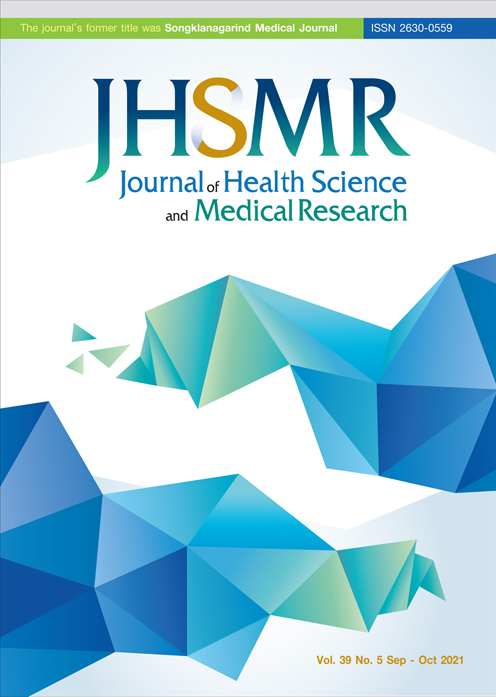Prevalence of Cancer Patients Requiring Palliative Care in Outpatient Clinics in a Tertiary Hospital in Southern Thailand
DOI:
https://doi.org/10.31584/jhsmr.2021798Keywords:
cancer, outpatient, palliative care, SPICT-LISAbstract
Objective: To estimate the prevalence of patients requiring palliative care in outpatient clinics and associated factors.
Materials and Methods: A cross-sectional study was conducted by retrospectively reviewing the electronic medical records of cancer patients visiting the outpatient clinics in the major tertiary care institution in southern Thailand during 1 January– 31 December 2018 from the Hospital Information System. The Supportive and Palliative Care Indicators Tool in Low Income Settings (SPICT-LISTM) was used to determine if the patients would benefit from palliative care. Forward stepwise multiple logistic regression was used to assess associations between potential factors and the need for palliative care.
Results: Nine thousand nine hundred and ninety medical records were reviewed. 3,628 (36.3%) patients were male and 6,324 (63.3%) were female with a median age of 58.7 years. The prevalence of cancer patients requiring palliative care according to the SPICT-LISTM criteria was 7.8%. Age was the main factor associated with palliative care need [odds ratio (OR)=1.03, 95% confidence interval (CI)=1.02-1.04]. Muslim patients had a significantly higher requirement for palliative care compared with Buddhist patients (OR=1.62, 95% CI=1.09-2.37). Although not statistically significant, malignant neoplasms of bone and articular cartilage were associated with higher palliative care need than lip, oral cavity and pharynx cancers (OR=5.35, 95% CI=0.69-29.40).
Conclusion: Muslim religion and having malignant neoplasms of bone and articular cartilage were associated with the highest palliative care need. Future studies should focus on more in-depth examination of the reasons these groups have higher needs for palliative care.
References
World Population Ageing Report. Aging [homepage on the Internet]. New York: United Nations; 2016 [cited 2020 Jan 24]. Available from: https://www.un.org/en/sections/issues-depth/ ageing
World Health Organization Definition of Palliative Care. Cancer [homepage on the Internet]. Geneva: WHO; 2002 [cited 2020 Jan 24]. Available from: https://www.who.int/cancer/palliative/ definition/en/
Virani S, Bilheem S, Chansaard W, Chitapanarux I, Daoprasert K, Khuanchana S, et al. National and subnational populationbased incidence of cancer in Thailand: assessing cancers with the highest burdens. Cancers (Basel) 2017;9:8.
Cruz-Oliver DM. Palliative care: an update. Mo Med 2017;114: 110–5.
Division of Non-Communicable Diseases. Number and rate of inpatients from 2016-2018 (hypertension, diabetic mellitus, cardiovascular diseases, chronic obstructive pulmonary disease) [homepage on the Internet]. Bangkok: Division of Non- Communicable Diseases, Thailand; 2018 [cited 2020 Jan 24]. Available from: http://www.thaincd.com/2016/mission/ documents-detail.php?id=13684&tid=32&gid=1-020
Mcateer R, Wellbery C. Palliative care: benefits, barriers, and best practices [monograph on the Internet]. Washington: American Family Physician; 2015 [cited 2020 Jan 24]. Available from: https://www.aafp.org/afp/2013/1215/p807.html
World Health Organization. Palliative care: for all ages and all diseases [homepage on the Internet]. Geneva: WHO; 2015 [cited 2020 Jan 24]. Available from: http://www.who.int/features/ 2015/south-africa-palliative-care/en/
Smith T, Coyne P, Cassel J. Practical guidelines for developing new palliative care services: resource management. Ann Oncol 2012;23:70–5.
World Health Organization. Noncommunicable diseases and their risk factors: palliative care [homepage on the Internet]. Geneva: WHO; 2019 [cited 2020 Jan 24]. Available from: https://www.who.int/ncds/management/palliative-care/en/
Supportive and Palliative Care Indicators Tool. SPICT-LISTM [homepage on the Internet]. Edinburgh: The University of Edinburgh; 2019 [cited 2020 Apr 24]. Available from: https:// www.spict.org.uk/the-spict/spict-lis/
Glare P, Semple D, Stabler S, Saltz L. Palliative care in the outpatient oncology setting: evaluation of a practical set of referral criteria. J Oncol Pract 2011;7:366–70.
Stubbs JM, Assareh H, Achat HM, Greenaway S, Muruganantham P. Specialist palliative care activity at an acute care tertiary hospital and its representation in administrative data. Am J Hosp Palliat Care 2020. doi: 10.1177/1049909120939861.
Hamano J, Oishi A, Kizawa Y. Identified palliative care approach needs with SPICT in family practice: a preliminary observational study. J Palliat Med 2018;21:992-8.
Highet G, Crawford D, Murray S, Boyd K. Development and evaluation of the supportive and palliative care indicators tool (SPICT): a mixed-methods study. BMJ Support Palliat Care 2014;4:285-90.
Bock R, Noortgate N, Piers R. Validation of the supportive and palliative care indicators tool in a geriatric population. J Palliat Med 2018;21:220-4.
Teunissen S, Haes H, Voest E, Graeff A. Does age matter in palliative care? Crit Rev Oncol Hematol 2006;60:152-8.
World Health Organization. Palliative care for older people: better practices [homepage on the Internet]. Geneva: WHO; 2011 [cited 2020 Jan 24]. Available from: http://www.euro.who. int/
Europe World Health Organization. What are the palliative care needs of older people and how might they be met? [homepage on the Internet]. Denmark: WHO; 2004 [cited 2020 Jan 24]. Available from: http://www.euro.who.int/__data/
Padela A, Zaidi D. The Islamic tradition and health inequities: A preliminary conceptual model based on a systematic literature review of Muslim health-care disparities. Avicenna J Med 2018; 8:1-13.
Gulia A, Byregowda S, Panda P. Palliative care in musculoskeletal oncology. Indian J Palliat Care 2016;22:244–51.
Martins A, Whelan J, Bennister LA, Fern L, Gerrand C, Onasanya M, et al. Qualitative study exploring patients experiences of being diagnosed and living with primary bone cancer in the UK. BMJ Open 2019;24:9.
Downloads
Published
How to Cite
Issue
Section
License

This work is licensed under a Creative Commons Attribution-NonCommercial-NoDerivatives 4.0 International License.
























